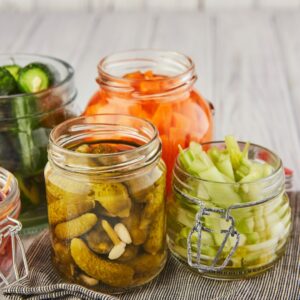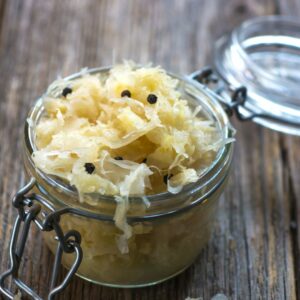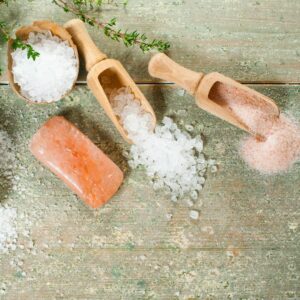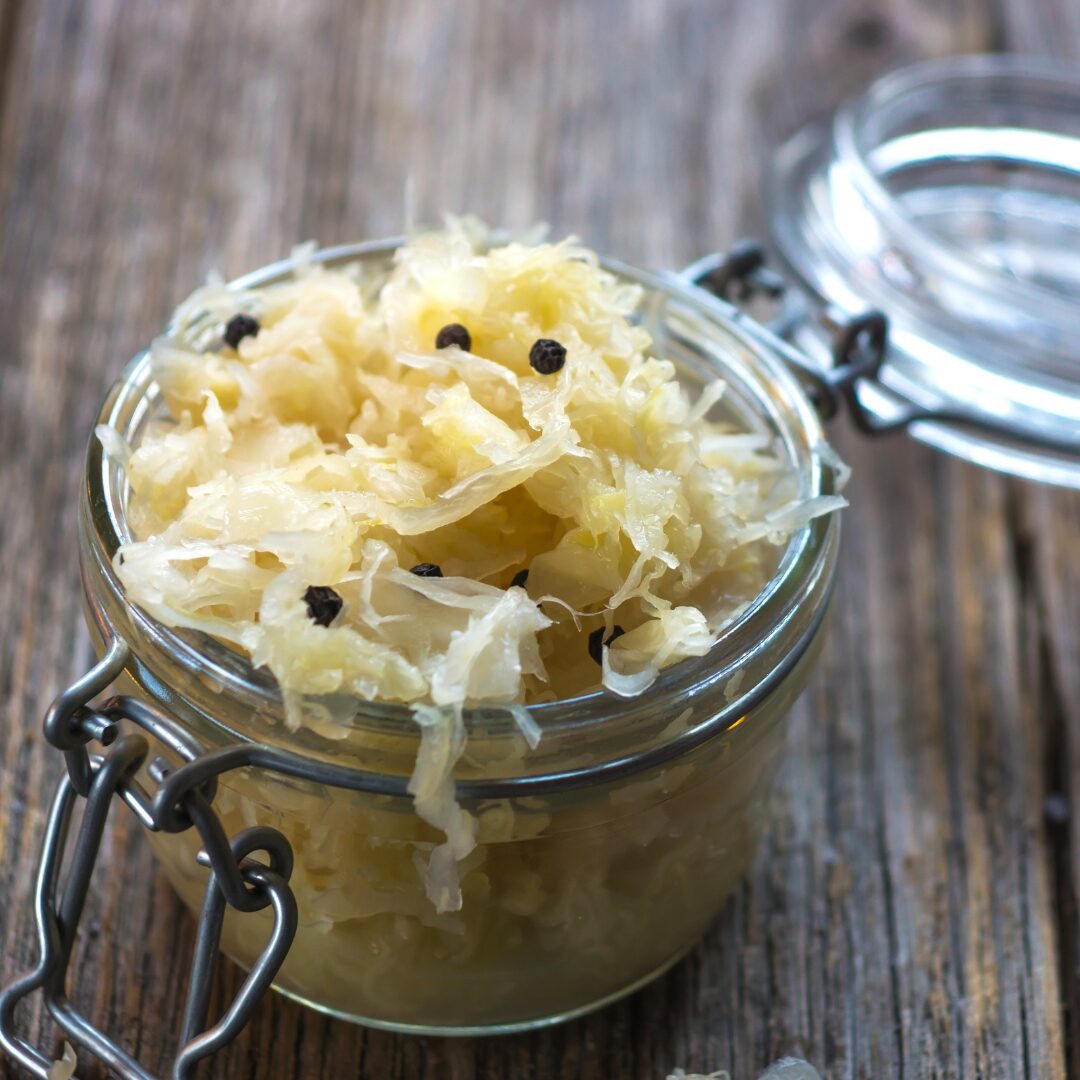.
Do you remember your granny going down into the basement and getting sauerkraut from a larger crock? No? Me neither – although I’ve grown up on a farm in rural Germany. Fermentation wasn’t „cool“anymore at that time and it was far more common to can your vegetables or store them in the freezer.
For several years now, the trend has gone back (or should I say “forward again”?) to fermenting food. And thank God for that! Fermentation has been a standard preserving method for thousands of years and it has so many benefits to our health and environment. But what exactly is fermentation and how can you ferment vegetables?
What is fermentation?
When hearing “fermentation”, most people will think about fermented vegetables like sauerkraut or kimchi. But there is a lot more to it! Sourdough, for example, is also a ferment. So are yogurt and kefir. And have you heard of Kombucha? Yep, also a ferment.
According to Wikipedia, fermentation is “a metabolic process that produces chemical changes in organic substances through the action of enzymes.”
That means, by feeding bacteria that are naturally present on fruit and vegetables and that we want to increase, we obtain food that is way more nutritious than the raw vegetables, tastes wonderful, and can be preserved for months (even years). The process where naturally present bacteria on the vegetables are used is called Wild Fermentation.
The science behind fermentation
When it comes to fermentation, we need certain bacteria and must prevent others. The most important of the “good” bacteria we need for fermentation is called lactobacillus. Lactic acid bacteria are practically everywhere: on vegetables, on our skin, and in our house, which is great for wild fermentation. During this process, they transform carbs into lactic acid and carbon dioxide (CO2) and prevent damaging bacteria from growing. Other important bacteria for fermentation are staphylococci and micrococci.
It depends on factors such as temperature, initial bacteria distribution, and oxygen which bacteria increase. If the fermentation happens without oxygen, these are the lactic acid bacteria, a fact we use to produce marvelously tasting fermented food.
There are three types of fermentation:
Wild fermentation
The process where naturally present microbes on foods or in the air are used for fermentation, especially if it occurs spontaneously, is called wild fermentation! Creating a sourdough starter, for example, is a wild fermentation process as it works with wild yeasts from the air. Another example of wild fermentation is sauerkraut. The naturally present microbes on the cabbage start (with salt and without oxygen) a fermentation process.
Lacto-fermentation
This is practically the same as wild fermentation, but it refers to the specific bacteria lactobacillus which is present on anything grown in the earth. Lactobacillus feeds on sugar and transforms it into lactic acid. Sauerkraut then is an example of both, wild and lacto-fermentation.
Culturing
Culturing means that to start a fermentation process you add a starter culture. Think of kefir, where you use water kefir grains, or kombucha where the SCOBY is responsible for fermentation. Another example of culturing would be yogurt. You either add some yogurt or yogurt starter cultures to the milk to start the fermentation process and make it yogurt.
Benefits of fermentation
Health benefits

Maybe you’ve heard the story of Captain Cook who prevented scurvy by making his crew eat sauerkraut every day. We know today that scurvy is caused by a severe vitamin C deficiency due to a limited diet. We also know now that the vitamin C content of vegetables increases through fermenting, as well as the content of other vitamins and minerals. That makes fermented goods a super-booster for our immune system.
Science has also found out that the iron content in lacto-fermented vegetable juices is to a certain extent better soluble than that in raw juice.
Additionally, vitamin B12 and folic acid can be found in fermented vegetables. As the only other sources for these nutrients are of animal origin, this is especially interesting for vegetarians and vegans.
Fermentation also eliminates various toxins such as polyphenols, citates, and tannins.
There is a connection between the ingestion of probiotics through fermented food and a reduction in blood pressure.
Fermented food can also help regulate inflammation in the gut and boost anti-inflammatory cytokines
And, last but not least, fermented goods help to improve digestion.
Environmental benefits
Despite all the amenities of modern life such as freezers, fridges, and canners, one-third (!) of food is still thrown away, most of it in the Western world. According to studies, 90 kilograms of food are thrown away per capita in Western Europe. Fermenting vegetables instead of storing them in the fridge till they are wilted, is a good way not only to reduce food waste but also to produce healthy food that lasts for months.
Another benefit of fermentation is that it does not require electricity. All the energy you need is a bit of muscle to chop and slice the vegetables and press them into a jar.
If you ferment vegetables that you have grown yourself or bought locally, you make sure to keep transportation routes short.
How does fermentation work?
There are two methods of lacto-fermentation
The brine method

Here, chopped or whole vegetables like carrot and cucumber sticks or cauliflower roses are put into a jar which is then filled up with brine until the vegetables are completely covered. Brine is essentially a water-salt solution with 25 – 50 g salt per liter of water, depending on the vegetables. Put the containers in a place without direct sunlight and temperatures between 13 and 24 °C and let the content ferment. If necessary, fill up with brine. The time of fermentation depends on the recipe.
The dry-salting method

Despite the name, this process is not dry. The vegetables are sliced as thin as possible and mixed with salt. Slicing breaks up the cell structure so that the salt can act more effectively and draw water out from the vegetables that gathers as brine. Tightly press the vegetables into your containers and fill up with the remaining brine. Let sit at a place without direct sunlight at a temperature between 13 and 24 °C. The time of fermentation depends on the recipe.
The role of salt in fermentation

Salt can preserve fresh vegetables, including all their vitamins for months or even years. It removes water from the cells which gathers as brine in the fermentation crock. Brine again is important as lactic acid bacteria live anaerobic, i.e. without oxygen which lots of other microbes need. To prevent the growth of those unwanted microbes, fermentations happen under the exclusion of oxygen, that is: in brine.
Salt also improves the consistency of the vegetables. It hardens the cells’ pectin so that they stay more stable and thus “crunchy”.
It may come as a surprise, but salt makes salty and thus adds to the taste.
It also helps to keep unwanted bacteria and yeasts in check that are more sensitive to a salty environment than lactic acid bacteria.
Without salt, there could be an increase of yeasts that transform sugar not into lactic acid but into alcohol.
Which salt to use?
For my fermented vegetables I only use natural salt that is rich in minerals but does not have any additives:
Rock salt
Himalayan salt or Redmond real salt are residues of prehistoric oceans. In the course of millions of years and under heat and pressure salt crystals rich in minerals were formed. The crystals are slightly pink and you can buy them finely ground. Rock salt does not dissolve completely in the brine but the residues sink to the bottom of the container and do not affect the quality of the fermented food.
Sea salt
The most common unprocessed sea salts are “Sel gris” (French for grey salt) and “fleur de sel” (French for salt flower). Both types are gathered by letting seawater evaporate in large basins until only the crystallized salt remains – together with residues of plankton, minerals, and micronutrients. These salts have a higher moisture content and are very mild in taste which makes them wonderful for fermentation. However, we can mostly buy them only as crystals which makes it a bit difficult to dissolve and form brine. To make it easier, you can always grind the crystals in a food processor or a mortar.
Iodized salt
There have been many discussions about the influence of iodized salt on the fermentation process. Some people believe that it hinders the lactic acid bacteria, and some say the iodine content is way too low to have any impact. I don’t use iodized salt.
Kosher salt
This salt is often recommended for fermentation as the flaky crystals have a large surface and thus can withdraw water well from the cells. Despite the fact, however, that kosher salt must not have any additives like iodine, it is highly processed. For that reason, I don’t use kosher salt.
Fermentation conditions
There are a few factors that are crucial for a successful fermentation:
Hygiene
Before you start fermenting, wash your hands thoroughly with warm water and soap. Don’t use antibacterial soap as this could inhibit the fermentation process – especially if you knead the cabbage. Wash your vegetables just with cold (!) water and don’t sterilize your equipment as this could kill our lactic acid bacteria. Just warm water and a bit of soap is enough to clean your equipment.
Temperature
I recommend a temperature between 13 and 24 °C for fermentation as this is the range where lactic acid bacteria thrive. It’s important to keep the temperature constant. The warmer it is, the faster acid is produced. If it’s too warm, however, the microorganisms can’t develop quickly enough, and the taste will suffer.
If it’s too cold (especially at the beginning), the lactic acid bacteria can’t increase fast enough which may lead to spoilage.
Light
A dark place is ideal for fermentation. This doesn’t mean that you have to store your fermentation crock in a pitch-dark hole, but it should also not be in direct sunlight. A shadowy corner in your kitchen or pantry where you can have an eye on it is great.
Oxygen
As talked about earlier, fermentation happens without oxygen, so we must make sure that the vegetables are always under the brine. With the brine technique, this can mean that we have to add brine after several days. When applying the dry-salting technique, we can make sure that our veggies are constantly covered with brine by putting a weight on them and pressing them down.
Time
So, how long does it take until the fermentation process is complete and you can eat your fermented veggies? That depends, mostly on the kind of vegetables but also on other factors like temperature and season. Technically speaking, veggies are fermented when they have reached a pH of under 4.6 (a pH of 7 is neutral and the lower the pH, the more acidic the medium). If you want to determine the pH, go ahead and put a pH test strip into the brine. But you can also just rely on your taste buds: try your fermented food and eat it when you like the taste.
Storage
Now that your fermented food is ready, how do you and how long can you store it?
How long can I store fermented food?
Unfortunately, there’s no definite answer to that. It depends on the acid that has formed in the fermented food. Some like very shortly fermented food that may not have reached a pH of below 4.6. If you want to store it, however, it should be sufficiently sour. If you’re not sure, test the pH with an indicator test strip.
You must keep in mind that fermented food is alive and therefore other rules apply than for, let’s say jam. Jam is safely stored in its glass jar and only if you open it will the decaying process start. Fermented food, however, is subject to constant change. Even when stored cold, the food will constantly become more acidic, however long it takes. But this doesn’t mean that it will become bad: as long as it tastes good, everything’s alright.
By rule of thumb, fermented food lasts between 6 and 12 months. I had to throw out some glasses before that time because their content had gone bad, but I also have a two-year-old pepper salsa that has become even better.
Where to store fermented food
Many people recommend, storing it in the fridge when the taste is to your liking. The cool temperature brings the fermentation process (almost) to a standstill and keeps the taste that you like. But a fridge is expensive and needs electricity.
If you are lucky and have a cool (below 10 °C but above 0°C) basement or even a root cellar, this is a great storage place for your fermented food! In that case, I recommend fermenting in larger containers because the food lasts longer the larger the container is. It is no coincidence that people used large fermentation crocks in the past.
Alternatively, you may preserve your fermented food in a water bath. With this method, you must be aware that precious vitamins and nutrients may be destroyed by the heat.
My basement is luckily very cool and I can store all my fermented food there. If your cellar is too warm for that, I recommend a second fridge.


0 Comments